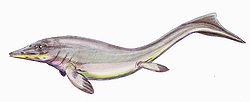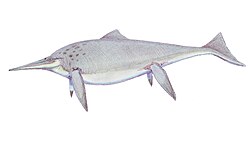Postcranial skeleton
Xinminosaurus has a total of 140 vertebrae. Of these, about 60 are located in front of the hips, a very high number, similar to some other ichthyosaurs. These vertebrae are followed by 3 sacral (hip) vertebrae and 77 caudal (tail) vertebrae. As in other ichthyopterygians, there is a prominent bend in the middle of the tail, where the neural spines slope forwards. In Xinminosaurus, the tail is bent downwards at a 35° angle, starting at caudal vertebra 38. [1]
Each scapula (shoulder blade) is composed of a broad, fan-like blade and a process that forms the shoulder joint, separated by a shaft. The latter of these structures has an outwards-bowed lower end with a notch and extends further forwards than backwards. [1] The coracoids (a pair of shoulder bones) are greater in width than length. [4] Xinminosaurus has short, wide collarbones. [1] The interclavicle (a shoulder bone between the collarbones) does not have a backwards projection. [4]
The long limb bones of Xinminosaurus are atypical for an ichthyosaur. The humeri (upper arm bones) of Xinminosaurus bear bladelike projections on their front edges, and Ichthyopterygian characteristic. The middle part of the humeri is not narrower than the ends of the bones. The lower ends of the ulnae (rear lower arm bones) are very large, curving upwards and extending more than halfway up along the shafts. Xinminosaurus has three upper wrist bones, which are rectangular in shape. The ulnares (bones below the ulnae) are the largest of these. Distinctive traits in the wrist of this genus include the coalescence of two of the lower wrist bones, distal carpals 3 and 4, and the absence of a bony distal carpal 1. The other distal carpal, distal carpal 2, is roughly elliptical in shape. While narrower, the metacarpals of Xinminosaurus resemble those of the non-ichthyosaurian ichthyopterygian Utatsusaurus , with the first being the shortest and the third and fourth being the longest. [1] The first four are shaped like hourglasses [4] while the fifth is shaped like a kidney. The number of bones in each digit in the foreflipper is 3, 5, 5, 5, and 2 respectively, small counts for an ichthyosaur. The phalanges (digit bones) are long and at least the upper ones are hourglass-shaped. [1] [4]
The upper and lower hindlimb bones are shorter than those of the forelimb. The upper ends of the tibiae (front lower hindlimb bones) are nearly twice as wide as their lower ends. There are two upper ankle bones in Xinminosaurus, the rear one (calcaneum) larger than the front one (astragalus) and both being vaguely round. The lower ankle bones resemble the lower wrist bones, with an absent distal tarsal 1 and combined distal tarsals 3 and 4. The metatarsals and phalanges are similar to the metacarpals and the phalanges in the foreflippers, although the exact number of phalanges in each digit in the hindflippers is unknown. [1]







